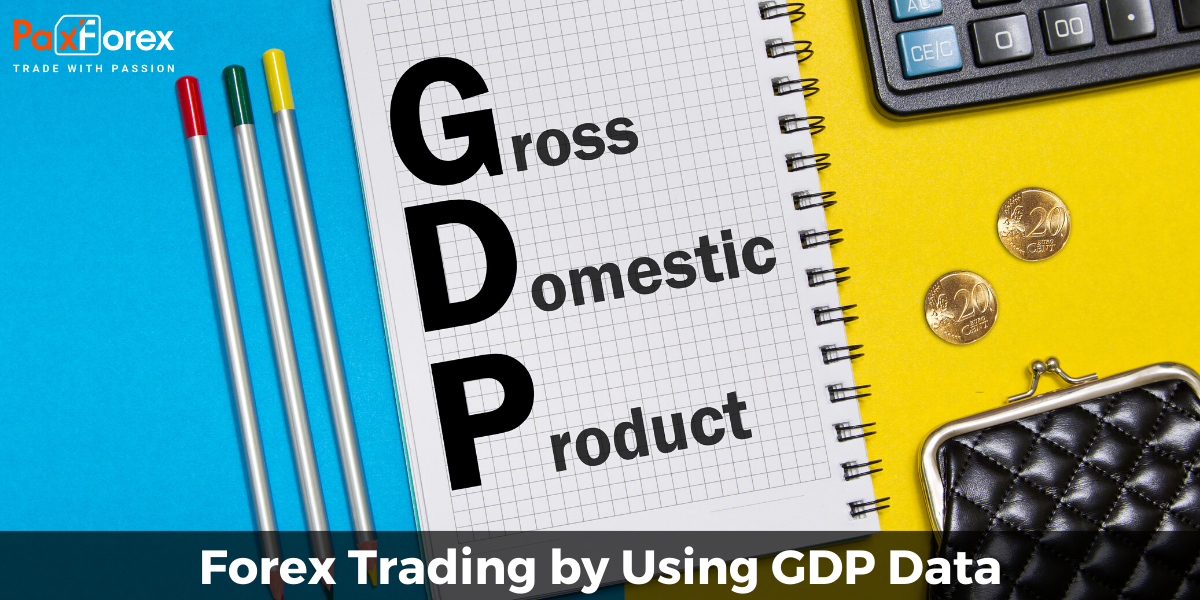
Economic data releases are essential for a foreign exchange trader. These important economic indicators create volatility, and plenty of speculation is always surrounding them, and The United States' gross domestic product (GDP) is one such report. Not only do Forex traders continue to monitor this important piece of economic data, they use it to either establish a new position or support a current one.
Gross domestic product is simply the total market value of all goods and services produced in a particular country. In the case of the United States, this total can be broken down into four main categories: consumption, investment, government expenditures (or spending) and net exports.
Consumption: Final consumption expenditures by households. These can include things like food, rent, fuel and other personal spending. Investment: Business spending on new plants and equipment, as well as household investment in property.
Government spending and investment: The total of all government spending, including public employee salaries and defense or social program benefits. Net Exports: Total final exports, minus total imports. A higher net export number is more productive for the economy.
The sum of these numbers is the United States' total gross domestic product, which can be compared to another year's performance in order to derive a percentage of GDP growth or contraction in a particular period.
Gross domestic product figures can be released on a monthly or quarterly basis. For the United States, the Bureau of Economic Analysis (BEA), a branch of the U.S. Commerce Department, releases final quarterly domestic figures – along with additional advanced or preliminary figures toward the end of each month. This report can also be released in either real or nominal conditions, the former being adjusted for the effects of inflation. The BEA also releases its GDP price index that has been used in competition with both consumer price index (CPI) and the personal consumption expenditures deflator as a gauge of consumer inflation.
Like any other piece of important economic data, the gross domestic product report holds a lot of weight for currency traders. It serves as evidence of growth in a productive economy, while signaling contraction in a withering one. As a result, currency traders will tend to seek higher rates of GDP or growth in a belief that interest rates will follow the same direction. If an economy is experiencing a good rate of growth, the benefits will trickle down to the consumer – increasing the likelihood of spending and expansion. In turn, higher spending leads to rising prices, which central banks attempt to tame through interest rate hikes.
Although there are three versions – advanced, preliminary and final – it's the relation between the three that is important, not just the individual releases. Currency professionals will emphasize the advanced reading when trading. But, they won't dismiss any differences when it comes to comparing the advanced with both the preliminary and final readings.
For example, a final reading of 1.5% growth compared to an earlier advanced release of 3.5% is worse off when compared to a similar 1.5% print in both advanced and final readings. A positive growth figure is always good for the economy, but not when a final GDP figure dips below the advanced reading.
What Forex traders can expect
There are three basic reactions to price action that a trader or investor can expect:
1. A lower-than-expected GDP reading will likely result in a selloff of the domestic currency relative to other currencies. In the case of the U.S., a lower GDP figure would signal an economic contraction and hurt the chances of a rise in U.S. interest rates – lowering the value or attractiveness of U.S. dollar based assets. Additionally, the further below an actual GDP reading is from the estimate, the sharper the decline in the dollar.
2. An expected reading requires a bit more comparison by the Forex investor. Here, the analyst or trader will want to compare the current reading to the previous quarter's reading – maybe even the previous year's reading. This way, a better evaluation of the situation can be gathered. Given this factor, you can expect that the resulting price action will tend to be mixed as the market sorts out the details.
3. A higher-than-expected reading will tend to strengthen the underlying currency versus other currencies. Therefore, a higher U.S. GDP figure will benefit the greenback, lending to some appreciation in the U.S. dollar against counter currencies; the higher an actual GDP reading is, the sharper the incline of the dollar's appreciation.
The U.S. gross domestic product report is (and always will be) an important release to consider when it comes to trading in Forex market. And, it's the traders that understand how to interpret the data and apply its relevance to a particular trade that come out on top.







